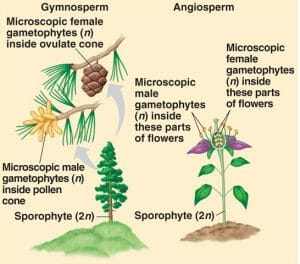Angiosperms and gymnosperms are two types of seed plants as shown by the suffix sperm which means “seed” in Latin. Gymnosperms first appeared on Earth during the Carboniferous period about 359-299 million years ago and they dominated the landscape by the Mesozoic era 251-65.5 million years ago. By the end of the Mesozoic era, angiosperm plants had taken over and they remain the most successful terrestrial plant group.
There are about 1,000 species of gymnosperms classified into 4 divisions: Coniferophyta, Cycadophyta, Ginkgophyta, and Gnetophyta. Plants in the Gnetophyta division are most closely related to angiosperms because they have xylem tissue. The Latin prefix gymnos means “naked” and refers to the seeds of the plants which are not enclosed in a fruit like angiosperm seeds are.
Angiosperms number over 260,000 species, second only to insects in terms of their diversity. The species are divided into monocots that have a single cotyledon and dicots (also called eudicots or true dicots) with two cotyledons. Monocots and dicots are identified, among other things by looking at their leaves. Monocots have parallel veins in their leaves while the veins in dicot leaves are branched. Their root systems are also different. Monocots have a network root system and dicots have a main taproot with lateral roots coming out of it.
Comparison Chart
| Angiosperms | Gymnosperms | |
|---|---|---|
| Seeds | Yes, usually inside an ovary (fruit) | Yes, not enclosed, usually found on cones, scales, or leaves |
| Leaves | Flat | Needle-like or scale-like |
| Has Flowers? | Yes | No |
| Reproductive System | In the flowers, unisexual or bisexual | Unisexual system in the cones |
| Type of Wood | Hardwood | Softwood |
| Uses | Food, medicines, clothing | Lumber, paper |
| Ploidy (number of sets of chromosomes) | Triploid | Haploid |
| Perennial? | No | Yes |
| Life Cycle | Seasonal, plant dies in autumn | Evergreen |
| Pollination Mechanism | Mostly by animals | Mostly by the wind |

The image above compares the reproductive systems of angiosperms and gymnosperms.
References
- Angiosperms vs. Gymnosperms. (n.d.). In Diffen.com. Retrieved from https://www.diffen.com/difference/Angiosperms_vs_Gymnosperms
- OpenStax College. (2017). Concepts of Biology. Houston, TX. Open Stax CNX. Retrieved from http://cnx.org/contents/b3c1e1d2-839c-42b0-a314-e119a8aafbdd@9.39
